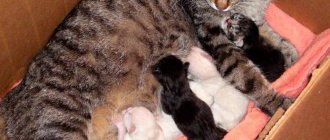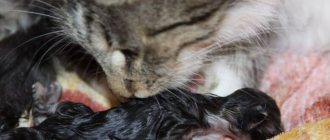A pregnant cat is very cute and scary at the same time. It’s scary because owners often don’t know how to prepare for childbirth and how to help their pet. Therefore, it is worth clarifying this issue.
For most people, cats are not just pets, but family members, and that is why owners constantly worry about their pets.
A very exciting and important moment for any owner is the birth of a cat. A cat is a wild animal by nature, so cats generally give birth without problems, but it is still necessary to prepare and be aware of possible difficulties and what needs to be prepared before this event.
How to prepare for the birth of a cat?
A cat does not need a birthing room like a human, but a special place will have to be arranged. A special box, which you can make yourself or buy at a pet store, is suitable as a “maternity box”. A cardboard box lined with newspapers or an old blanket will do just fine.
If the cat has access to the street, then in the last stages it is better not to let her out in order to prevent birth on the street. Also in the last days it is worth ensuring peace, absence of noise and other irritants and monitoring whether the animal’s condition changes.
In case complications arise during childbirth, it is better to prepare some supplies in advance; here is the necessary list:
- Any antiseptic
- Towels
- Treated scissors
- Pipette
- Sterile medical gloves
- Veterinarian phone number
The veterinarian should be chosen taking into account the possibility of a house call and preferably around the clock, because labor can begin at any moment. If it is not possible to call a veterinarian in a given locality, you can consult by telephone and follow the doctor’s instructions.
Cat behavior before giving birth: signs, symptoms, temperature
When the final stage of pregnancy approaches, the cat feels the approach of labor and special signs appear in its behavior.
The behavior of a cat before giving birth has the following signs, and the onset of labor is predicted by symptoms:
- The cat begins to look for a place to make a “nest” for itself.
- Immediately a couple of days before giving birth, the cat’s appetite begins to decrease, sometimes even to the point of losing it completely.
- Unusual character traits and habits may appear: for example, if a cat has always been independent and not very sociable, then before giving birth she may not leave the owner’s hands. Such sudden changes in habits and behavior are harbingers of an imminent birth.
- The cat becomes restless.
- The cat's mammary glands swell and increase in size.
If such signs of an approaching birth become noticeable, you should prepare and pay more attention to your pet, monitor how the cat behaves, what it does and how it feels.
It will be useful to read specialized literature or watch videos of cat births.
Correct birth process
The first stage of labor begins with contractions as the uterus begins to open. After some time, the plug comes off, and gradually the contractions become more frequent and stronger.
At the second stage, the uterus is fully dilated and the first kitten begins to move along the birth canal. Kittens may be born with or without amniotic sacs. When a cat gives birth, it ruptures the amniotic sac and licks the kitten. After the kitten is born, the placenta comes out, and cats usually eat it.
It is important to remember the number of placentas delivered, and if there are fewer placentas delivered than kittens, you need to seek help from a veterinarian. Placenta remaining in the birth canal can lead to infections that are dangerous to the health and life of the cat.
A pregnant cat has diarrhea before giving birth, what should I do?
If a pregnant cat has any health problems, this will definitely worry the owner. Thus, pregnant cats often experience loose stools. But you should know that diarrhea in a pregnant cat a couple of days before giving birth is absolutely normal and natural. But you should not worry only if the animal has no other signs of illness.
Cat giving birth
Well, now in more detail about the birth process itself: a cat’s labor consists of three phases:
The first phase: a decrease in body temperature to 36.7 C. From this moment, the cat, which was previously calm, loses its appetite and is looking for a nest; it may try to climb into a closet or into bed. She often licks her genitals. She may start vomiting. For many cats, their water begins to break several hours before the first contractions (yellow, pus-like fluid from under the tail). But it also happens that almost immediately before childbirth. Calmly transfer the cat to the place prepared for it and stay with it until the cat gets used to it and feels calm in this “maternity hospital”.
At this time, breathing usually quickens, trembling may appear, and the pulse rate increases. The cat rushes about, often changes position, and milk may begin to leak from the nipples. At the same time, the muscles of the uterus begin to contract, while the kittens move from the horns of the uterus to the body and cervix. The contractions began. Wash what can and should be washed around the nest, including your hands. Take a book (radio, TV, player), sit close to the nest, turn on the bright light and get ready to be close to the woman in labor without interruption. Most often this is the most important thing and that is enough. If you and your cat have a friendly relationship - at least - (not to mention the relationship with you as a mother), the cat feels calm and confident, and this is three-quarters of success. Talk to her as much as possible, gently and slowly, stroke her tummy from the throat and down. This phase can last from 12 to 24 hours. It lasts the longest in primiparous cats. If this phase lasts more than 24-25 hours or the contractions are accompanied by severe pain for the cat, be sure to invite a doctor.
It is important to remember that some forms of weak labor can be caused by excessive arousal or psychological stress during labor. During childbirth, there should be no strangers in the room where the cat is, as this also negatively affects the progress of labor. The presence of the owner near the cat during childbirth, caring and calm behavior have a beneficial effect on its condition.
During the second phase of labor contractions, strong pushing begins, which simultaneously sets in motion the muscles of the abdomen and diaphragm.
At the beginning of this phase, you may be able to notice a small amount of fawn or greenish fluid flowing from the vagina. The leakage of amniotic fluid occurs when the amniotic sac (the protective membrane covering the fetus) ruptures as the fetus passes through the birth canal, namely when it enters the vaginal canal. At this time, the cat lies on its stomach or on its side, less often stands or squats on its hind legs. As soon as you feel that it is already pushing and the birth canal has begun to open, place a support under its hind legs - your palm, for example, so that it can rest - lying down on her side or on her back, or even squatting - as instinct tells her. Keep tissues or toilet paper on hand. If the cat craps a little - nothing, this is normal, calmly wipe it off and do not let it out of the nest.
Part of the amniotic sac covering the kitten is shown at the vaginal exit. If the kitten's head is visible in it, that's not bad; most likely, this means that minimal help will be required. But even if there is a tail, don’t be afraid, we have everything at hand. I am sure that in the absence of severe pathology, it is possible to help any cat give birth - without caesarean section. Sometimes the amniotic sac is already ruptured before the kitten comes out.
From the moment when the kitten’s head appears at the exit of the birth canal until its full appearance, a quarter of an hour usually passes. If pushing continues for 30 minutes without results, call your veterinarian. If there is further delay, call a doctor immediately.
The kitten's muzzle and front paws should constantly move outward with each push, but in no case should there be reverse movements. With classic presentation, the kitten is positioned with its head and front paws towards the exit. But in almost half of the cases, kittens walk with their hind legs, which is also considered normal and usually does not complicate the course of labor. As soon as the kitten is born, it is necessary to immediately release it from the amniotic sac. This is usually done by the mother cat herself, but some inexperienced or nervous cats may not do this. In this case, you must help the kitten, otherwise he may suffocate.
The umbilical cord does not come off during childbirth. The placenta (baby place) is riddled with a large number of blood vessels, and if the umbilical cord is injured, the kitten will be covered in blood. If the mother cat does not release the kitten from the amniotic sac within 1 - 2 minutes after the birth of the kitten, then do it yourself. After this, take the kitten in your hands, wrapping it, for example, in a soft cloth or towel. The kitten's head should be supported so that it does not hang freely, but has support. Bend the kitten's body into an arc so that the chest reaches the knees. The nose should be pointed down towards the floor. Straighten your body. Bend again as you did the first time. After several such manipulations, the kitten’s water usually breaks through the nose and mouth and thus clears the airways. You can remove amniotic fluid from the kitten’s nose and mouth using a small syringe (without a needle) or a small rubber bulb. After the airways are cleared, rub body, muzzle, chest of the kitten with a harsh towel. If even after rubbing the kitten does not breathe and does not make a voice, give it mouth-to-mouth artificial respiration. Repeat this procedure until the kitten begins to breathe, which can be seen by the movement of the chest. Rough toweling and flexion-extension procedures are also recommended if the kitten was born lethargic or if the mother cat does not lick it after birth. Usually the cat -the mother bites the umbilical cord when the kitten has already been licked and cleared of the fetal membrane. If the cat has not chewed the umbilical cord 15 minutes after the kitten is born, cut it yourself. To do this, tie the umbilical cord with a clean thread at a distance of 2 - 4 cm from the abdomen. After this, you can cut the umbilical cord from the side of the kitten's belly. If the kitten has swallowed too much water, then after resuscitation, put the kitten on a warm heating pad (the hand feels warm, about 40 degrees). If the kitten was born weak, then again put it on a warm heating pad. Usually the afterbirth comes out with the kitten or a little later. Make sure that the number of afterbirths is equal to the number of kittens born. A placenta that has not passed away can become a cause of inflammation of the uterus or a source of any infection. Typically (though not necessarily), the cat eats the afterbirth after each kitten. You can let her eat 1 - 2 placenta, but no more, as otherwise it will cause vomiting and diarrhea. If everything goes as usual, without delays in contractions and in the advancement of the fetus for more than 5 minutes, just help her with your hands: stroke, a little rest your hand on the sternum and ribs to help push and expel the fetus.
If there are no contractions, but the water has broken. If a tail has appeared (and even more so, a paw) and the kitten does not go further. If you notice that some periods of labor are prolonged or the cat looks exhausted, immediately call a doctor.
If the kitten has already appeared at the exit of the vagina, but does not move further, then you must help the cat. Wash your hands thoroughly and lubricate your index finger with Vaseline. Now insert a finger (or two fingers) into the cat's vagina and grab the kitten with them. Try to determine where his head, front legs and hind legs are. You must drag the kitten very carefully, by the front paws, synchronously with each attempt. It is best and most convenient to take the kitten under the shoulders from below, so as not to put too much pressure on the head. Do not rupture the amniotic sac containing the kitten. If the kitten's head is too large to fit through the vulva, the "exit" can be gently widened slightly with your fingers, making circular movements in the vagina around the kitten's head. The full, maximum dose of oxytocin is an ampoule for a large cat. But this is already dangerous, so only for the most serious indications!
During childbirth, if the cat is obviously tired, the pregnancy is multiple, the birth is long, it makes sense to administer 0.5-1.5 ml subcutaneously. gamavita. This is a vitamin preparation - it will restore the cat’s strength, stimulate labor, and have a positive effect on the condition of newborns.
However, we are giving birth. The kitten came out halfway, we pulled him up a little (a little!!!), he came out in full, behind him, on the umbilical cord, we gently pulled out the placenta. Your first and very necessary move is to carefully tear the film with your finger where it covers the kitten’s mouth so that he can open it in the air. Second, we cut the umbilical cord with scissors (preferably sterile) at a distance of about two centimeters from the tummy. If the mother actively licks the newborn, wait a few seconds to see if he mumbles. If she is carried away by eating the placenta or is generally convinced that this is all “none of her business,” then you need to free the kitten from the film and start petting it. He beeped - order. No - turn your head down and slap your lungs and body in general a little. If he doesn’t puff or squeak, then we blow into his mouth so that his lungs expand, and we exhale for him, gently squeezing them. He meowed - great - give it for licking or wipe it with a clean napkin yourself - in front of a very stupid mother. You should definitely let her eat the placenta!
As soon as the first one rushes to the nipples, you can continue.
The third phase of labor includes the period of time the uterus is calm after the birth of each kitten and the time during which the placenta is released. During this phase, the cat lies quietly and licks the kittens, some cats get up to drink water. This quiet period from the birth of one kitten to the next can last from 10 - 15 minutes to several hours, but usually does not last longer than 2 hours. There is more between the first and second horns of the uterus than between kittens from the same horn. There is no need to rush her too much here. Just make sure that she doesn’t lay down on one kitten when she gives birth to the next ones, especially if she has long hair. It’s better to let them yell on the sidelines, within the nest, nothing will happen to them. The number of kittens in one litter is usually from 2 to 6. The average duration of labor is from 2 to 6 hours. Sometimes normal labor lasts more than 6 hours, very rarely up to 24 or even 36 hours.
It doesn’t cost anything to determine by touch that the kittens in a cat have “run out” - the cat becomes completely soft after the last kitten - in half an hour maximum. Otherwise, the uterus is tense. However, if you injected a lot of oxytocin, this will happen later. When everyone has been born, we carefully lay a new blanket with a rag away from the nest, transfer all the kittens onto it and, without allowing the mother to see the children, quickly change the bedding in the nest. If you are not afraid, you can put the kittens on the third cloth and watch how she drags them all back to the nest. This very delicate activity requires excellent dexterity and coordination, especially with a high box.
If you are still not sure that the cat will not give birth in your absence, at least do not turn off the light! In the dark, she can really mess things up...
After giving birth, your cat may have bloody discharge. Don’t be scared the first day - it’s not as scary as it seems. If the discharge continues for more than a week or has a greenish tint, it’s better to show it to a doctor.
Feed kittens only with warm milk (cat's milk substitute). Otherwise, digestion does not work.
Good luck, easy birth for your cat and healthy kittens!!!
If your cat is shaking before giving birth, what should you do?
There are two options to consider here:
- Before giving birth, cats breathe faster. Sometimes it becomes so frequent that the pregnant cat appears to be trembling or shaking.
- The cat is really shaking. This may be a banal reaction to a stressful situation, as well as a reaction to changes in body temperature. Therefore, if there are no other warning signs, there is no need to worry. However, if your cat has a high fever, loses consciousness, and also has unpleasant discharge from the genitals, you should immediately call a veterinarian, as this is a characteristic sign of complications during childbirth.
Cat pregnancy, important nuances
Pregnancy in cats follows a specific cycle. According to generally accepted rules, cats that have value should be bred. If everything is done according to the rules, the mating is planned and registered in the breed club.
As practice shows, most inexperienced owners are faced with the pregnancy of their wards after the fact, without keeping an eye on the ward during heat. The first sign of pregnancy can be considered the absence of estrus, which should occur according to the cycle. Typically the cycle is 3–4 weeks. So, if your cat has not started meowing and calling for a male cat, it is worth analyzing whether she could have had contact with a male during her last heat.
If your cat does not have a breed value, in order to avoid pregnancy and the hassle associated with it, it is recommended to sterilize your pet before the onset of sexual heat. With a responsible approach, you will maintain the health of your pet and will not encounter the problem of “adopting” kittens.
According to a strange “tradition,” it is believed that a cat bears and gives birth to kittens without complications. In fact, planning pregnancy and caring for the expectant mother is of enormous importance. Like all living beings, cats experience serious stress during pregnancy and require increased nutrition and care. After the birth of kittens, many cats, especially purebred cats, may suffer from complications.
Note! In early pregnancy, the owner has a choice - medical abortion or castration of the cat. In the late stages of pregnancy, the owner will have to come to terms with and take responsibility for the life and health of the kittens.
Regardless of whether you wanted to get kittens or not, as soon as you find out that your cat is pregnant, she needs to be seen by a veterinarian. Before planned mating, both parents are vaccinated and free of parasites. If preventive measures were not carried out before mating, some of them can be carried out in the first trimester. Some types of parasites can infect kittens in utero, leading to serious postpartum complications or death of the entire litter.
If you have decided that your pet will give birth to kittens, you must take the veterinarian's advice with full responsibility. The sooner you balance the diet of the expectant mother, the higher the chances of giving birth to full-term kittens and maintaining the health of the pet.
Important! If your cat is giving birth for the first time, you should prepare for possible complications. Some animals suffer from postpartum eclampsia, and with prolonged labor, there is a risk of inflammation of the uterus.
In early pregnancy, you need to enrich your cat's diet with calcium and other beneficial microelements. Calcium deficiency is likely to lead to postpartum eclampsia. Make sure that while your cat has a good appetite, she remains active and mobile. Obesity is guaranteed to lead to complications during childbirth.
The first symptoms of pregnancy in cats appear approximately three weeks after conception. In the third week, you may notice that your cat's nipples are enlarged and slightly swollen. The glands acquire a more saturated, pink hue. These changes occur against the background of the pet’s normal activity. In the fourth week, you may notice the first roundness of your belly. If a cat is carrying 2–4 kittens, this sign may appear at 5 weeks. During pregnancy, swelling of the nipples becomes obvious by the 4th week.











